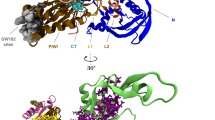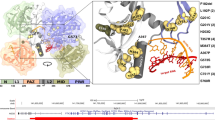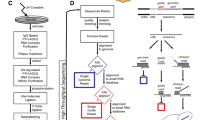Abstract
Small RNAs (miRNA, siRNA, and piRNA) regulate gene expression through targeted destruction or translational repression of specific messenger RNA in a fundamental biological process called RNA interference (RNAi). The Argonaute proteins, which derive from a highly conserved family of genes found in almost all eukaryotes, are critical mediators of this process. Four AGO genes are present in humans, three of which (AGO 1, 3, and 4) reside in a cluster on chromosome 1p35p34. The effects of germline AGO variants or dosage alterations in humans are not known, however, prior studies have implicated dysregulation of the RNAi mechanism in the pathogenesis of several neurodevelopmental disorders. We describe five patients with hypotonia, poor feeding, and developmental delay who were found to have microdeletions of chromosomal region 1p34.3 encompassing the AGO1 and AGO3 genes. We postulate that haploinsufficiency of AGO1 and AGO3 leading to impaired RNAi may be responsible for the neurocognitive deficits present in these patients. However, additional studies with rigorous phenotypic characterization of larger cohorts of affected individuals and systematic investigation of the underlying molecular defects will be necessary to confirm this.
Similar content being viewed by others
Log in or create a free account to read this content
Gain free access to this article, as well as selected content from this journal and more on nature.com
or
References
Valencia-Sanchez MA, Liu J, Hannon GJ, Parker R . Control of translation and mRNA degradation by miRNAs and siRNAs. Genes Dev 2006; 20: 515–524.
Lewis BP, Burge CB, Bartel DP . Conserved seed pairing, often flanked by adenosines, indicates that thousands of human genes are microRNA targets. Cell 2005; 120: 15–20.
Meister G . Argonaute proteins: functional insights and emerging roles. Nat Rev Genet 2013; 14: 447–459.
Yang JS, Lai EC . Dicer-independent, Ago2-mediated microRNA biogenesis in vertebrates. Cell Cycle 2010; 9: 4455–4460.
Kataoka Y, Takeichi M, Uemura T . Developmental roles and molecular characterization of a Drosophila homologue of Arabidopsis Argonaute1, the founder of a novel gene superfamily. Genes Cells 2001; 6: 313–325.
Giraldez AJ, Cinalli RM, Glasner ME et al. MicroRNAs regulate brain morphogenesis in zebrafish. Science 2005; 308: 833–838.
Liu J, Carmell MA, Rivas FV et al. Argonaute2 is the catalytic engine of mammalian RNAi. Science 2004; 305: 1437–1441.
Stark KL, Xu B, Bagchi A et al. Altered brain microRNA biogenesis contributes to phenotypic deficits in a 22q11-deletion mouse model. Nat Genet 2008; 40: 751–760.
Forstner AJ, Degenhardt F, Schratt G, Nothen MM . MicroRNAs as the cause of schizophrenia in 22q11.2 deletion carriers, and possible implications for idiopathic disease: a mini-review. Front Mol Neurosci 2013; 6: 47.
Martínez JE, Tuck-Muller CM, Gasparrini W, Li S, Wertelecki W . 1p microdeletion in sibs with minimal phenotypic manifestations. Am J Med Genet 1999; 82: 107–109.
Biswas S, Munier FL, Yardley J et al. Missense mutations in COL8A2, the gene encoding the alpha2 chain of type VIII collagen, cause two forms of corneal endothelial dystrophy. Hum Mol Genet 2001; 10: 2415–2423.
Gottsch JD, Sundin OH, Liu SH et al. Inheritance of a novel COL8A2 mutation defines a distinct early-onset subtype of Fuchs corneal dystrophy. Invest Ophthalmol Vis Sci 2005; 46: 1934–1939.
Mok JW, Kim HS, Joo CK . Q455V mutation in COL8A2 is associated with Fuchs corneal dystrophy in Korean patients. Eye 2009; 23: 895–903.
Meng H, Matthaei M, Ramanan N et al. L450W and Q455K Col8a2 knock-in mouse models of Fuchs endothelial corneal dystrophy show distinct phenotypes and evidence for altered autophagy. Invest Ophthalmol Vis Sci 2013; 54: 1887–1897.
Schratt G . MicroRNAs at the synapse. Nat Rev Neurosci 2009; 10: 842–849.
Rio Frio T, Bahubeshi A, Kanellopoulou C et al. DICER1 mutations in familial multinodular goiter with and without ovarian Sertoli-Leydig cell tumors. JAMA 2011; 305: 68–77.
Vorstman JA, Staal WG, van Daalen E, van Engeland H, Hochstenbach PF, Franke L . Identification of novel autism candidate regions through analysis of reported cytogenetic abnormalities associated with autism. Mol Psychiatry 2006; 1: 18–28.
Zhang F, Gu W, Hurles ME, Lupski JR . Copy number variation in human health, disease, and evolution. Annu Rev Genomics Hum Genet 2009; 10: 451–481.
Yang JS, Lai EC . Alternative miRNA biogenesis pathways and the interpretation of core miRNA pathway mutants. Mol Cell 2011; 43: 892–903.
Acknowledgements
We thank the patients and their families for their kind cooperation. This study makes use of data generated by the DECIPHER Consortium. A full list of centers who contributed to the generation of the data is available from http://decipher.sanger.ac.uk and via email from decipher@sanger.ac.uk. Funding for the project was provided by the Wellcome Trust. Electronic database information is available from Online Mendelian Inheritance in Man (http://www.omim.org); Decipher–Wellcome Trust Sanger Institute (https://www.decipher.sanger.ac.uk). This case report was supported in part by a grant from the Italian Ministry of Health (Ricerca Corrente 2013). MJT is funded by the University of Washington Medical Genetics Postdoctoral Fellowship (5T32 GM007454).
Author information
Authors and Affiliations
Corresponding author
Ethics declarations
Competing interests
The authors declare no conflict of interest.
Rights and permissions
About this article
Cite this article
Tokita, M., Chow, P., Mirzaa, G. et al. Five children with deletions of 1p34.3 encompassing AGO1 and AGO3. Eur J Hum Genet 23, 761–765 (2015). https://doi.org/10.1038/ejhg.2014.202
Received:
Revised:
Accepted:
Published:
Issue date:
DOI: https://doi.org/10.1038/ejhg.2014.202
This article is cited by
-
MACF1, Involved in the 1p34.2p34.3 Microdeletion Syndrome, is Essential in Cortical Progenitor Polarity and Brain Integrity
Cellular and Molecular Neurobiology (2022)
-
Molecular mechanisms underlying nuchal hump formation in dolphin cichlid, Cyrtocara moorii
Scientific Reports (2019)
-
Schilbach–Rott syndrome associated with 9q22.32q22.33 duplication, involving the PTCH1 gene
European Journal of Human Genetics (2019)
-
Prenatal diagnosis of 1p34.3 interstitial microdeletion by aCGH in a fetus with jaw bone abnormalities
Molecular Cytogenetics (2016)



